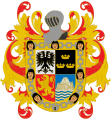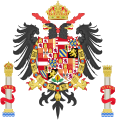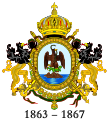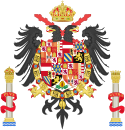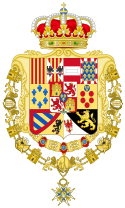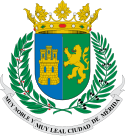Godło Meksyku
Godło Meksyku – godło Meksyku przyjęte 16 września 1968 roku.
 | |
| Informacje | |
| Wprowadzono | 1968 |
|---|---|

Opis
Na godle Meksyku umieszczono wizerunek orła, siedzącego na opuncji i pożerającego węża. Prawdopodobnie jest to grzechotnik zielony (Crotalus viridis). Był on otaczany kultem[1]. Obraz ten nawiązanie do legendy Azteków, żyjących w Meksyku przed XVI wiekiem. Według niej zobaczyli oni orła trzymającego grzechotnika w szponach i w tym miejscu postanowili założyć stolicę.Ten znak znajduje się także w centralnej części flagi państwa[2].
Historia
Obecny wariant flagi o proporcjach 4:7 został przyjęty 16 września 1968 roku[2]. Pierwsza wersja flagi została ustanowiona dnia 2 listopada 1821 przez władcę Meksyku Augustyna I. W późniejszym okresie jej forma pozostawała ta sama, zmieniały się natomiast szczegóły godła (np. w okresach cesarstwa orzeł miał koronę, a w okresach republikańskich pozostawał bez niej). W latach 1821-1968 trójkolorowa flaga bez godła wykorzystywana była jako bandera handlowa, została jednak wycofana z powodu możliwości pomylenia jej z flagą Włoch.
Herb Hernána Cortésa
Nowa Hiszpania 1528-1530
Matka Boża z Guadalupe wykorzystana jako symbol powstania w 1810
Herb Cesarstwa Meksyku 1821–1823
Godło Republiki z lat 1823-1864 i 1867-1893 (istniał w wielu wariantach)
Republika Rio Grande 1840
Republika Jukatanu 1841-1848
II Cesarstwo Meksyku 1864–1867
Meksykańskie Stany Zjednoczone 1893-1916
1916-1934
1934-1968
Zobacz też
Przypisy
- ↑ Jerzy Wrona, Gady, płazy, ryby, mięczaki. Zwierzęta na flagach i w herbach państw, „Aura” (nr 6), 2006, s. 31-33.
- ↑ a b Stephen Woodman, The Story Behind the Mexican Flag, Culture Trip [dostęp 2019-11-06].
Media użyte na tej stronie
Coat of arms of Mexico (1934-1968)
Autor: Heralder, Licencja: CC BY-SA 3.0
Greater Coat of Arms of Coat of arms of Charles I of Spain (Charles V as Holy Roman Emperor), (1530-1556)
Autor: Ludovicus Ferdinandus can have elements by Sodacan and Heralder, Licencja: CC BY-SA 3.0
Banner of Guadalupe adopted by Miguel Hidalgo y Costilla. It was first used in the town of Atotonilco in September 16th, 1810; and captured by the Royalist Army in the Aculco Battle, in November 7th, 1810.
Coat of arms of Mexico (1893-1916)
Autor: Ludovicus Ferdinandus can have elements by Sodacan and Heralder, Licencja: CC BY-SA 3.0
Depiction of the fundational myth of Mexico-Tenochtitlan: colorized impression of the back-side stone engraving of "Teocalli of the Sacred War". An eagle which exhales the atl-tlachinolli (war symbol) ("water, burnt-earth" difrasismo) is perched on a nopal with human heart blooms, amid the waters of Lake Texcoco, and from which emerges the heart of Copil, nephew of Mexi-Huitzilopochtli.
Autor: Sarumo74, Licencja: CC BY-SA 3.0
Escudo de armas del imperio este escudo fue el que oficialmente se uso para los asuntos del gobierno como sello y escudo se oficializo el 1 de noviembre de 1865. Diseño basado en http://www.museohistoriamexicana.org.mx/themes/coleccion/msxix_45.html, http://www.conevyt.org.mx/cursos/cursos/mexico/contenidos/recursos/revista/1_4.htm, http://www.hubert-herald.nl/Mexico1.htm
Autor: Heralder, Licencja: CC BY-SA 3.0
Royal Greater Coat of Arms of Spain, 1761-1868 / 1874-1931 - Version with the Collars of the Order of the Golden Fleece and the Order of Charles III
Coat of Arms of The First Mexican Empire (1822-1823)
The Tovar Codex, attributed to the 16th-century Mexican Jesuit Juan de Tovar, contains detailed information about the rites and ceremonies of the Aztecs (also known as Mexica). The codex is illustrated with 51 full-page paintings in watercolor. Strongly influenced by pre-contact pictographic manuscripts, the paintings are of exceptional artistic quality. The manuscript is divided into three sections. The first section is a history of the travels of the Aztecs prior to the arrival of the Spanish. The second section, an illustrated history of the Aztecs, forms the main body of the manuscript. The third section contains the Tovar calendar. This illustration, from the second section, depicts the founding of Tenochtitlan (present-day Mexico City). An eagle is shown devouring a bird while perched on a flowering cactus. The cactus grows from a rock in the middle of a lake. Footsteps of the Mexicans are shown approaching the base of the cactus. On the right is Tenoch (known from his glyph of a flowering cactus), who led the Aztecs to Tenochtitlan. On the left is Tochtzin, or Mexitzin (known from his glyph of a rabbit), who came from Calpan (known from the glyph of a house with a flag), Tenoch's co-ruler. The two rulers sit on basketwork thrones. At upper right is the symbol of Copil, son of Malinalxochitl, or five dots with crossed arrows, on a shield. The Aztecs, guided by the prophecies of Huitzilopochtli (the god of the sun and war), ended their migration from farther north by building Tenochtitlan, on an island in a lake where an eagle held a snake perched on a flowering nopal (prickly pear) cactus. The cactus grew, according to their mythology, from the heart of Copil, son of Huitzilopochtli's sister, which had been flung onto the island. His symbol of five dots represents the Aztec belief that the world was a flat surface divided into five directions (north, south, east, west, and the center, where their capital was located).
Aztec mythology; Aztecs; Codex; Indians of Mexico; Indigenous peoples; Kings and rulers; Mesoamerica; Tovar Codex
Autor: HansenBCN, Licencja: CC BY 3.0
Coat of arms granted to Hernán Cortes in 1525 by the king and emperor Charles I of Spain.
Coat of arms of Mexico (1823-1864, 1867-1893)
Coat of arms of Mexico (1916-1934)
Escudo de Armas de la Ciudad de Mérida, Yucatán, México.
Escudo partido en pal, esto es verticalmente de arriba a abajo, en dos cuarteles iguales. El primero (izquierda) en campo azur (azul) ostenta un castillo de oro, y el segundo (derecha) un león rampante de oro en campo de sinople (verde). El escudo va timbrado, es decir rematado en su cúspide, con corona real, abierta. La forma o contorno del escudo corresponde al estilo heráldico español: cuadrilongo con su base redondeada. [1]
Autor: Heralder, Licencja: CC BY-SA 3.0
Arms of Charles I of Spain (1520-1530) Greater arms as Spanish Monarch and Holy Roman Emperor (as Charles V), (1530-1556)
Autor: Keepscases, Licencja: CC BY-SA 3.0
Seal (coat of arms) of the Republic of the Rio Grande

